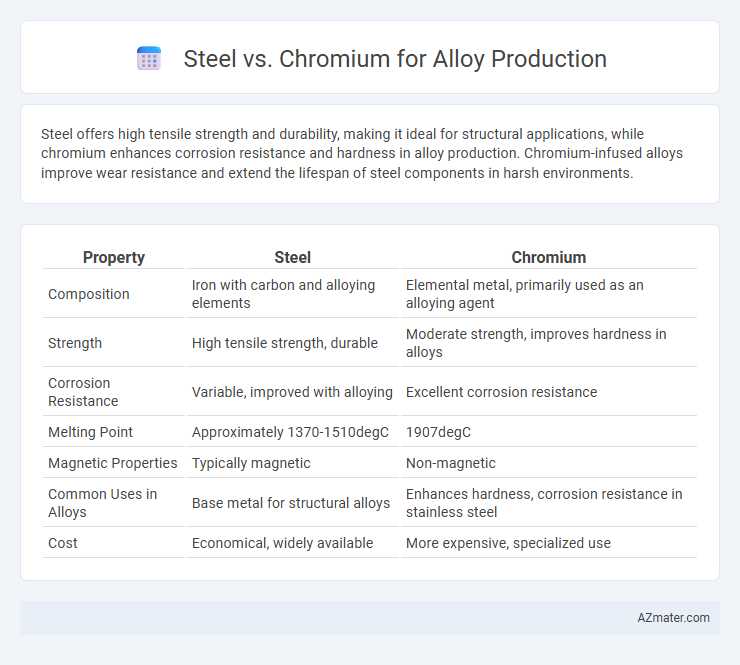Steel offers high tensile strength and durability, making it ideal for structural applications, while chromium enhances corrosion resistance and hardness in alloy production. Chromium-infused alloys improve wear resistance and extend the lifespan of steel components in harsh environments.
Table of Comparison
| Property | Steel | Chromium |
|---|---|---|
| Composition | Iron with carbon and alloying elements | Elemental metal, primarily used as an alloying agent |
| Strength | High tensile strength, durable | Moderate strength, improves hardness in alloys |
| Corrosion Resistance | Variable, improved with alloying | Excellent corrosion resistance |
| Melting Point | Approximately 1370-1510degC | 1907degC |
| Magnetic Properties | Typically magnetic | Non-magnetic |
| Common Uses in Alloys | Base metal for structural alloys | Enhances hardness, corrosion resistance in stainless steel |
| Cost | Economical, widely available | More expensive, specialized use |
Introduction to Alloy Production
Steel and chromium are fundamental materials in alloy production, with steel serving as a versatile base alloy primarily composed of iron and carbon, while chromium is a key additive known for enhancing corrosion resistance and hardness. The integration of chromium into steel results in stainless steel, which exhibits superior durability and resistance to oxidation, making it essential in construction, automotive, and tool manufacturing industries. Alloy production leverages the distinct properties of both elements to create materials tailored for specific mechanical and environmental requirements.
Overview of Steel and Chromium
Steel, an iron-carbon alloy, serves as the foundation for numerous industrial applications due to its strength, durability, and versatility. Chromium, a transition metal, is primarily valued for its corrosion resistance, hardness, and ability to enhance alloy properties when combined with steel. The integration of chromium into steel alloys significantly improves wear resistance and oxidation stability, making it essential in manufacturing stainless steel and high-performance alloys.
Key Properties of Steel in Alloys
Steel exhibits exceptional tensile strength and hardness, making it a fundamental component in alloy production for structural applications. Its high carbon content allows for versatile heat treatment, enhancing wear resistance and durability in diverse environments. Steel's ability to form stable microstructures also supports improved machinability and corrosion resistance when combined with other elements.
Essential Characteristics of Chromium
Chromium significantly enhances steel alloy production by providing exceptional corrosion resistance, increased hardness, and improved tensile strength. Its high melting point and ability to form a stable oxide layer protect the alloy from oxidation and wear under extreme conditions. These essential characteristics make chromium indispensable in producing stainless steel and other durable, high-performance alloys.
Comparative Strength: Steel vs Chromium
Steel alloys exhibit high tensile strength and remarkable toughness, making them suitable for structural and heavy-duty applications, while chromium, primarily used as an alloying element rather than a standalone metal, significantly enhances corrosion resistance and hardness when added to steel. The addition of chromium improves steel's wear resistance and oxidation stability, essential in stainless steel and high-performance alloys. Pure chromium's strength is lower compared to most steel varieties, but its alloying properties are key to developing steel grades with superior durability and environmental resistance.
Corrosion Resistance in Alloy Applications
Chromium significantly enhances corrosion resistance when added to steel alloys, forming a passive oxide layer that protects the underlying metal from oxidation and rust. Stainless steel, typically containing 10-20% chromium, exhibits superior durability in corrosive environments compared to plain carbon steel. This chromium-induced corrosion resistance is critical for alloy applications in marine, chemical, and automotive industries where long-term material integrity is essential.
Cost Analysis: Steel vs Chromium
Steel remains significantly more cost-effective than chromium for alloy production due to lower raw material prices and widespread availability. Chromium, despite its superior corrosion resistance and hardness properties, commands higher costs that impact overall alloy manufacturing budgets. Manufacturers often balance chromium's premium pricing against steel's affordability to optimize alloy performance within budget constraints.
Environmental Impact of Alloying Elements
Steel production consumes significant energy and releases CO2, with alloying elements like chromium influencing its environmental footprint. Chromium mining and refining generate hazardous waste and energy-intensive emissions, contributing to soil and water pollution. Selecting low-impact chromium sources and improving recycling practices can reduce alloy production's overall ecological damage.
Industrial Applications and Use Cases
Steel alloys dominate industrial applications due to their exceptional mechanical strength, corrosion resistance, and cost-effectiveness, making them ideal for construction, automotive, and heavy machinery manufacturing. Chromium, often added to steel alloys, enhances hardness, wear resistance, and oxidation resistance, critical for producing stainless steel used in aerospace, chemical processing, and medical instruments. The synergy of steel and chromium in alloy production results in materials that withstand extreme environments, ensuring durability and longevity in industrial use cases.
Future Trends in Alloy Material Selection
Future trends in alloy material selection emphasize the shift towards advanced steels with enhanced corrosion resistance and strength, driven by innovations in steel metallurgy. Chromium remains a crucial alloying element due to its ability to form protective oxide layers, promoting durability in harsh environments. Emerging techniques like powder metallurgy and additive manufacturing integrate high-chromium steels to meet demands for lightweight, high-performance materials in aerospace and automotive industries.

Infographic: Steel vs Chromium for Alloy Production
 azmater.com
azmater.com